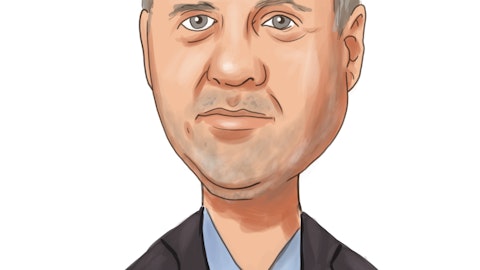QuinStreet, Inc. (NASDAQ:QNST) Q1 2024 Earnings Call Transcript November 1, 2023
QuinStreet, Inc. misses on earnings expectations. Reported EPS is $-0.19396 EPS, expectations were $-0.04.
Operator: Good day, and welcome to QuinStreet’s Fiscal First Quarter 2024 Financial Results Conference Call. Today’s conference is being recorded. Following prepared remarks there will be a question-and-answer session. At this time, I would like to turn the conference over to Senior Director of Investor Relations and Finance, Robert Amparo. Mr. Amparo, you may begin.
Robert Amparo: Thank you, operator, and thank you everyone for joining us as we report QuinStreet’s fiscal first quarter 2024 financial results. Joining me on the call today are Chief Executive Officer, Doug Valenti; and Chief Financial Officer, Greg Wong. Before we begin, I would like to remind you that the following discussion will contain forward-looking statements. Forward-looking statements involve a number of risks and uncertainties that may cause actual results to differ materially from those projected by such statements and are not guarantees of future performance. Factors that may cause results to differ from our forward-looking statements are discussed in our recent SEC filings, including our most recent 8-K filing made today and our most recent 10-K filing.
Forward-looking statements are based on assumptions as of today, and the Company undertakes no obligation to update these statements. Today, we will be discussing both GAAP and non-GAAP measures. A reconciliation of GAAP to non-GAAP financial measures is included in today’s earnings press release, which is available on our Investor Relations website at investor.quinstreet.com. With that, I will turn the call over to Doug Valenti. Please go ahead, sir.
Doug Valenti: Thank you, Rob. And thank you all for joining us. FY Q1 was another successful quarter. Non-insurance revenue grew 18% year-over-year and represented 79% of total revenue. We continued to invest in important product and growth initiatives across the business, including in staying positioned to take full advantage of the revamp of auto insurance client spending. We did all that while continuing to deliver on our commitment to maintain our strong financial position, once again demonstrating operational and financial excellence and the resilience of our business model. Auto insurance clients are communicating their intentions for calendar year 2024, and those indications support our expectation of a significant positive inflection in their spending, beginning in January.
We are spring loaded for that inflection and would expect total company revenue to jump dramatically in the back half of the fiscal year and adjusted EBITDA to grow faster than revenue. We expect auto insurance revenue to be even further up and to the right over the longer term, eventually returning to and exceeding prior peak levels as carriers benefit from compound rate increases, product optimizations, and cooling inflation and supply chains, thus allowing the shift to digital and performance marketing reassert itself of the dominant long-term trend. Turning to our outlook. First for the current fiscal year which ends next June. We expect full fiscal year 2024 revenue to grow between 5% and 15% year-over-year, implying as I indicated earlier, a significant positive inflection in auto insurance spending in the back half.

Auto insurance clients are giving us considerable detail about their footprint and budget expansion plans for January forward. While it is still difficult to predict the exact scale and slope of the auto insurance revamp, our bottoms up estimates imply expected total company quarterly revenue in the second half of the fiscal year to average over $180 million per quarter. We expect quarterly adjusted EBITDA margin in the second half to be between 5% and 10% of revenue. For the current quarter, our fiscal Q2, we expect total company revenue to be between $113 million and $118 million, in line with typical sequential seasonality. We expect adjusted EBITDA to be between negative $0.5 million and positive $0.5 million. We will, of course, continue to maintain our strong balance sheet and strong overall financial position and discipline.
Finally, our long-term outlook has never been better. We are extraordinarily well positioned to take advantage of the revamp of auto insurance client spending, and to expand our product and market footprint in that important client vertical. We also continue to scale our non-insurance businesses, which now total about $400 million in annual revenue and grew 18% year-over-year last quarter and at a 19% compound annual growth rate over the past three years. With that, I’ll turn the call over to Greg.
Greg Wong: Thank you, Doug. Hello and thanks to everyone for joining us today. For the September quarter, total revenue was $123.9 million. Adjusted net loss was $1.4 million or $0.03 per share and adjusted EBITDA was $1 million. Non-insurance revenue was $98.5 million or 79% of Q1 revenue and grew 18% year-over-year. Looking at revenue by client vertical, our financial services client vertical represented 58% of Q1 revenue and was $72.1 million. We continue to see excellent performance from our personal loans, credit cards, and banking client verticals, which grew 33% combined. Our home services client vertical represented 40% of Q1 revenue and grew 6% year-over-year to $49.4 million. Our strategy to drive long-term growth here is simple: One, grow our business from our existing 15 or so service offerings, examples being window replacement, solar sales and installation, and bathroom remodeling, none of which we believe are anywhere close to their full potential; and two, expand into new service offerings where we see the opportunity to at least triple the number of these sub verticals we currently serve.
This multipronged growth strategy is expected to drive double-digit average annual growth for the foreseeable future. Other revenue was the remaining $2.4 million of Q1 revenue. Turning to the balance sheet, we closed the quarter with $56.3 million of cash and equivalents and no bank debt. As we look ahead into Q2, I’d like to remind everyone of the seasonality characteristics of our business, as I do every year at this time. The December quarter, our fiscal second quarter typically declines about 10% sequentially. This is due to reduced client staffing and budgets during the holidays and end of year period, a tighter media market and changes in consumer shopping behavior. This trend generally reverses in January. For fiscal Q2, our December quarter, we expect revenue to be between $113 million and $118 million, in line with typical sequential seasonality and adjusted EBITDA to be between a negative $500,000 and a positive $500,000.
In summary, let me reiterate Doug’s earlier points. One, we are extraordinarily well positioned to take advantage of the re-ramp of auto insurance client spending, which we expect to begin in January. Two, we will also continue to scale our non-insurance businesses, which now total about $400 million in annual revenue and grew 18% year-over-year last quarter. And three, we expect total company revenue to jump dramatically in the back half of our fiscal year, and we expect adjusted EBITDA to increase even faster. With that, I’ll turn the call over to the operator for Q&A.
See also 14 Best Cyclical Stocks To Invest In and 15 Countries with the Highest Number of Military Satellites in Orbit.
Q&A Session
Follow Quinstreet Inc (NASDAQ:QNST)
Follow Quinstreet Inc (NASDAQ:QNST)
Receive real-time insider trading and news alerts
Operator: [Operator Instructions] Our first question comes from John Campbell with Stephens Inc. Please go ahead.
Jonathan Bass: Hey guys. This is Jonathan Bass on for John Campbell. It looks like the home services segment saw a little bit of deceleration this quarter. Can you give some color on what you’re seeing there and then maybe what specific verticals are seeing slower growth?
Doug Valenti: Yes. Jonathan, home services grew, I think it’s 6%, as Greg reported, year-over-year. We expect home services to grow this full calendar — or sorry, this full fiscal year at double digits, which has been the case for the past several years there. So I kind of — I guess I kind of say nothing to see there. Just some quarters, between things converge in one way and other quarters they converge in others. So, I don’t expect that there’s no — nothing to see or nothing to report in terms of any structural deceleration.
Jonathan Bass: Okay. Got it. And then, with your commentary around the expected insurance marketing spend coming in January, do you guys have any insight on what the potential trajectory of the spend could look like throughout the year?
Doug Valenti: We don’t have — we have some input on that from clients there. There is at least one client that’s given us very specific numbers in terms of what their plans are by state and coverage for the first half of calendar ‘24, which of course would be the second half of our fiscal ‘24. They haven’t given us much color beyond that, just general guidance in terms of their hopes and expectations for the year. So trajectory wise, what we are assuming is that the ramp will begin in January and be a pretty significant inflection as we’ve said for the past few quarters, and that — and a pretty big step function increase over the December quarter’s numbers, which are running along multiyear lows, as you know and that that ramp would continue and go up in the June quarter based on what clients have told us their plans are.
Very typically, the March quarter is a peak, and then we go down a little in the June quarter. But based on what the clients are telling us, we actually expect to have the step function up from December to the March quarter, and then they continue to ramp up and to the right through the June quarter. And then, probably typical seasonality will kick in, which would be pretty flat June to September quarter. And then, as Greg said, a downward shift in the December quarter as we work through that sequential seasonality.
Operator: Our next question comes from Jim Goss with Barrington Research. Please go ahead.
Jim Goss: I was wondering, Doug, how many of your various insurance carrier clients are exhibiting the types of signs that would support your optimism about a sharp turn? And how varied do you expect the timing of any recovery among those plans to be in terms of, not all happening at once perhaps, but maybe it’s over a several weeks or several months period. What do you think — I know you said you don’t really know the scale and the slope, but maybe there’s a little more color you can give to those expectations.
Doug Valenti: Yes. Jim, I’d say, the majority of our carrier clients have expressed that next year, in particular, and most beginning in January, will be a higher spend year for them in the channel because of their success in getting rate increases over the past few years and because of a cooling inflationary environment. To your point, they have varying degrees of plans for how and where they’re going to ramp, some with decent specificity. Fortunately, some of our bigger ones have given us that kind of level of detail, and others with less. But on balance, what we’ve done is we’ve taken the — and then the inputs from all of the clients, and we have very good and probably the best relationships with these clients in the industry.



